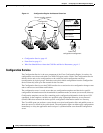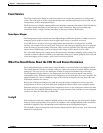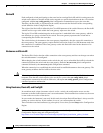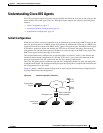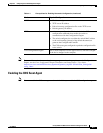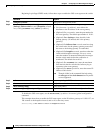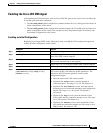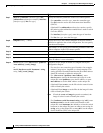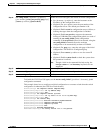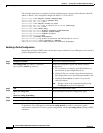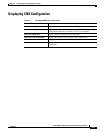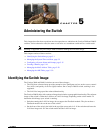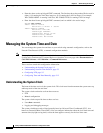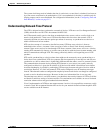
4-10
Catalyst 2960 and 2960-S Switch Software Configuration Guide
OL-8603-09
Chapter 4 Configuring Cisco IOS Configuration Engine
Configuring Cisco IOS Agents
Step 7
discover {controller controller-type | dlci
[subinterface subinterface-number] | interface
[interface-type] | line line-type}
Specify the interface parameters in the CNS connect profile.
• For controller controller-type, enter the controller type.
• For dlci, enter the active data-link connection identifiers
(DLCIs).
(Optional) For subinterface subinterface-number, specify
the point-to-point subinterface number that is used to search
for active DLCIs.
• For interface [interface-type], enter the type of interface.
• For line line-type, enter the line type.
Step 8
template name [ ... name] Specify the list of CNS connect templates in the CNS connect
profile to be applied to the switch configuration. You can specify
more than one template.
Step 9
Repeat Steps 7 to 8 to specify more interface parameters and CNS
connect templates in the CNS connect profile.
Step 10
exit Return to global configuration mode.
Step 11
hostname name Enter the hostname for the switch.
Step 12
ip route network-number (Optional) Establish a static route to the Configuration Engine
whose IP address is network-number.
Step 13
cns id interface num {dns-reverse | ipaddress
| mac-address} [event] [image]
or
cns id {hardware-serial | hostname | string
string | udi} [event] [image]
(Optional) Set the unique EventID or ConfigID used by the
Configuration Engine.
• For interface num, enter the type of interface–for example,
ethernet, group-async, loopback, or virtual-template. This
setting specifies from which interface the IP or MAC address
should be retrieved to define the unique ID.
• For {dns-reverse | ipaddress | mac-address}, enter
dns-reverse to retrieve the hostname and assign it as the
unique ID, enter ipaddress to use the IP address, or enter
mac-address to use the MAC address as the unique ID.
• (Optional) Enter event to set the ID to be the event-id value
used to identify the switch.
• (Optional) Enter image to set the ID to be the image-id value
used to identify the switch.
Note If both the event and image keywords are omitted, the
image-id value is used to identify the switch.
• For {hardware-serial | hostname| string string | udi}, enter
hardware-serial to set the switch serial number as the
unique ID, enter hostname (the default) to select the switch
hostname as the unique ID, enter an arbitrary text string for
string string as the unique ID, or enter udi to set the unique
device identifier (UDI) as the unique ID.
Command Purpose



